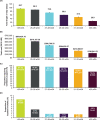Prevalence and clinical characteristics of perinatal chronic lung disease by infant gestational age
- PMID: 32474477
- PMCID: PMC7990434
- DOI: 10.3233/NPM-200412
Prevalence and clinical characteristics of perinatal chronic lung disease by infant gestational age
Abstract
Background: Children with perinatal chronic lung disease (CLD) are at elevated risk for severe respiratory syncytial virus (RSV) disease in the first two years of life. The American Academy of Pediatrics policy does not recommend RSV immunoprophylaxis for infants with CLD born at ≥32 weeks' gestational age (wGA). The objective of this study was to describe the number and clinical characteristics of US infants in this population.
Methods: Birth hospitalization data from the Kids' Inpatient Database were utilized to estimate the prevalence of CLD (International Classification of Diseases, Ninth Revision [ICD-9] = 770.7) in 2003-2012 overall and by gestational age (ICD-9 = 765.21-765.29). CLD birth hospitalizations were evaluated by length of stay, costs, ventilatory support, and inpatient mortality.
Results: A total of 33,537 infants were diagnosed with CLD, representing 0.2% of US births; 79% had wGA coded in the database. Among infants with CLD with wGA, 3.5% were born at >32 wGA, representing 7 of every 100,000 US births, or approximately 300 infants annually. Across all wGA categories, birth hospitalization length of stay and costs were elevated, and mechanical ventilation use ranged from 73% to 97%. All-cause inpatient mortality was highest among those <27 wGA and >32 wGA.
Conclusions: Approximately 300 infants born at >32 wGA are diagnosed with CLD annually in the United States. The all-cause perinatal mortality rate is high in this population. The rationale for excluding this small but high-risk group of infants from the recommendations for RSV immunoprophylaxis is unclear.
Keywords: Bronchopulmonary dysplasia; immunoprophylaxis; respiratory syncytial virus.
Conflict of interest statement
This research was funded by AstraZeneca, the manufacturer of palivizumab. The sponsor was involved in the design and conduct of the study and approval of the manuscript. Decision rights about content belonged collectively to the authors and not to the sponsor. No substantive changes were made to the manuscript as a result of the company review. KM is on the speakers bureau for AstraZeneca. XJ provided consultant/research support for AstraZeneca. CSA is an employee of AstraZeneca.
Figures



Similar articles
-
Respiratory syncytial virus hospitalization outcomes and costs of full-term and preterm infants.J Perinatol. 2016 Nov;36(11):990-996. doi: 10.1038/jp.2016.113. Epub 2016 Aug 4. J Perinatol. 2016. PMID: 27490190 Free PMC article.
-
Trends in Respiratory Syncytial Virus and Bronchiolitis Hospitalization Rates in High-Risk Infants in a United States Nationally Representative Database, 1997-2012.PLoS One. 2016 Apr 6;11(4):e0152208. doi: 10.1371/journal.pone.0152208. eCollection 2016. PLoS One. 2016. PMID: 27050095 Free PMC article.
-
The 2014-2015 National Impact of the 2014 American Academy of Pediatrics Guidance for Respiratory Syncytial Virus Immunoprophylaxis on Preterm Infants Born in the United States.Am J Perinatol. 2018 Jan;35(2):192-200. doi: 10.1055/s-0037-1606352. Epub 2017 Sep 7. Am J Perinatol. 2018. PMID: 28881376 Free PMC article.
-
Respiratory syncytial virus hospitalizations in US preterm infants after the 2014 change in immunoprophylaxis guidance by the American Academy of Pediatrics.J Perinatol. 2020 Aug;40(8):1135-1144. doi: 10.1038/s41372-020-0689-y. Epub 2020 Jun 4. J Perinatol. 2020. PMID: 32499597 Free PMC article. Review.
-
Populations at risk for developing respiratory syncytial virus and risk factors for respiratory syncytial virus severity: infants with predisposing conditions.Pediatr Infect Dis J. 2003 Feb;22(2 Suppl):S33-7; discussion S37-9. doi: 10.1097/01.inf.0000053883.08663.e5. Pediatr Infect Dis J. 2003. PMID: 12671450 Review.
Cited by
-
Healthcare resource utilisation and costs in infants with confirmed respiratory syncytial virus infections: a national population cohort study.BMC Infect Dis. 2024 Oct 14;24(1):1152. doi: 10.1186/s12879-024-09971-0. BMC Infect Dis. 2024. PMID: 39396944 Free PMC article.
References
-
- Romagnoli C, Zecca E, Tortorolo L, Vento G, Tortorolo G. A scoring system to predict the evolution of respiratory distress syndrome into chronic lung disease in preterm infants. Intensive Care Med. 1998;24(5):476–80. - PubMed
-
- Sinkin RA, Cox C, Phelps DL. Predicting risk for bronchopulmonary dysplasia: Selection criteria for clinical trials. Pediatrics. 1990;86(5):728–36. - PubMed
-
- IMpact RSV Study Group. Palivizumab, a humanized respiratory syncytial virus monoclonal antibody, reduces hospitalization from respiratory syncytial virus infection in high-risk infants. Pediatrics. 1998;102(3):531–7. - PubMed
-
- Healthcare Cost and Utilization Project (HCUP) [Internet]. Rockville, MD: Agency for Healthcare Research and Quality; [cited 2019 Dec 26]. Available from: www.hcup-us.ahrq.gov/kidoverview.jsp.
MeSH terms
LinkOut - more resources
Full Text Sources
Other Literature Sources
Medical

